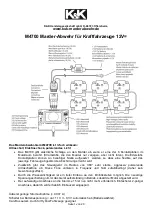
27
3.8.2
Attach eNB to Wall
1.
Put the eNB against the wall where you want it to be installed, and mark the 3 drilling
hole locations, as shown in Figure 3-25.
Figure 3-25: Wall Mount
2.
Drill three ½-inch/12-mm diameter sized holes on the wall where marked. Fix the eNB
unit on the wall using the M10*80 expansion screws.
3.
Continue on to section 3.8.3.
3.8.3
Recommendations for Installing
In general, it is best to keep the RF cable length between the eNB and antenna as short as
possible to minimize signal attenuation. Typically, the eNB will be located within a few feet
from the antenna.
This section provides guidance on GPS placement considerations and explains how to install
the eNB and an omni or directional antenna on an outdoor tower, building, or other structure.
3.8.3.1
GPS Positioning Considerations
Consider the following concerning GPS positioning when installing the eNB.
The GPS antenna should be free of any major blocking from buildings in the vicinity. Make
sure the space atop within 45 to 90 degrees is not blocked by any buildings.
Avoid installing the GPS near other transmitting and receiving devices. The GPS should be
at least 3 feet (.9 meters) from other transmitting devices.
The GPS antenna should be installed within 45 degrees to the lightning rod.
3.8.3.2
Install Omnidirectional Antenna
Following are guidelines for installing an omnidirectional antenna at the cell site.
•
The mounting pole diameter must be between 1.4 inches to 2 inches (35 to 50 millimeters).
Typically, operators use a 2-inch/50-mm round, steel-made pole.
•
The top of the pole and the clamp beneath the antenna should be at the same level once
the omni is installed on the pole.
•
For optimal performance, ensure the omni antenna is precisely vertical.








































